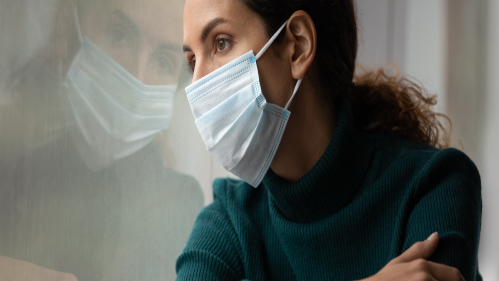Dealing With Residual COVID Trauma as the Masks Come Off

Rutgers expert explains the relationship between trauma, the brain and the body and how to process it as we move forward
For two years, the social and emotional costs of school closures, business interruptions, news of death and illness, and vacillating guidance from officials have taken a toll on all of us.
With mask mandates and other COVID protocols set to expire around the country, will we let out a collective sigh of relief and instantly return to normal? Or will we suffer the aftershocks of pandemic trauma for years to come?
“Whether a harrowing event or a series of stressful moments that culminate over time, trauma can echo and etch itself into our brain as we remember it throughout our lives,” says Tracey Shors, a Distinguished Professor in Behavioral and Systems Neuroscience in the Department of Psychology at Rutgers-New Brunswick’s School of Arts and Sciences.
Shors, author of Everyday Trauma: Remapping the Brain’s Response to Stress, Anxiety, and Painful Memories for a Better Life, discusses how the body processes trauma and therapeutic approaches to reduce its negative effects as we move forward.
What kind of trauma did we collectively experience during the pandemic? What is the impact of that stress on our brains and bodies?
In my research, I have found there are two forms of “everyday trauma.” In the first, the traumatic event itself is relatively short and discrete but nonetheless, memories of the experience live on in our thoughts. The second form of everyday trauma is associated with more chronic experiences that are persistently stressful. The pandemic is one of those. It goes on with no end in sight, filling our brains with thoughts of sadness, anxiety, sickness and death. There are many sources of everyday trauma, from chronic illness, caretaking, discrimination and poverty to emotional abuse. These experiences are especially stressful when they are unpredictable. When a stressor or a trauma goes on day after day, it can induce symptoms such as anxiety and depression, as well as repetitive thoughts about what happened or could have been.
Why do traumatic memories linger even after the source of the trauma dissipates?
Our body typically responds to an extremely traumatic event with the so-called “fight-or-flight” response, which is fast and helps us respond in the moment by giving us quick access to energy. Another response arises later as the body releases stress hormones into the blood to help it recover. Stress hormones then travel to the brain to change its anatomy and function, as it makes memories about what happened.
Our brains are so good at making memories that we think of them as real, but they are not. They are generated by anatomical structures and something resembling electricity in our brains. As we ruminate on our past, we create more memories in our brains as the old memories become attached to what is happening now. This is normal. This is how our brain works. But it is good to understand how our brain works and to be more aware of our ruminating brain.
How can people cope with reliving the trauma that may come?
Even once the pandemic has passed, more traumas will surely arise. And therefore, we need to keep our brain fit for the future.
In my book, I describe a brain fitness program known as MAP Training that combines “mental and physical” exercise with meditation and aerobic exercise. It takes a bit of effort but not much time or any money. And it works to reduce stress and anxiety, depression and even those nagging ruminative thoughts that many of us have.
For example, we did a study during the pandemic with K-12 teachers, who said that they were having lots of anxiety and stress-related symptoms related to teaching under these unusual conditions. We provided them with our brain fitness program. Afterwards, the teachers reported feeling much better with less stress and depression, as well as fewer anxious and ruminative thoughts. These results suggest that we should be training our brains now, not later. Our brain is like a muscle. To stay fit, it needs exercise – mental and physical exercise – no matter what is happening.
Studies show violence against women has increased during this time. Additionally, 35 percent of women who left or lost their jobs during the pandemic are still unemployed. What are the variabilities between men and women when it comes to trauma?
In general, women are two to three times as likely to be diagnosed with post-traumatic stress disorder, depression and anxiety disorders. And studies indicate that stress-related symptoms such as anxiety and depression have increased dramatically in women during the pandemic. The reasons for these differences are many: hormonal changes across the lifespan, lack of control and helplessness, sex differences in diagnosis and differences in life experience. For example, women are more likely than men to experience sexual and physical violence in their lifetime. They are also more likely to ruminate in general, especially about traumatic events from the past. Some of our reactions to the pandemic can be addressed with clinical intervention.


